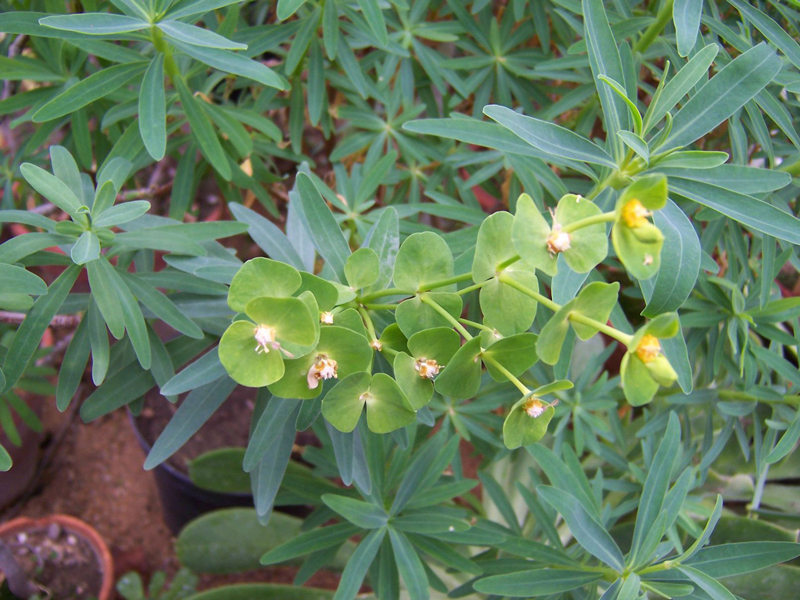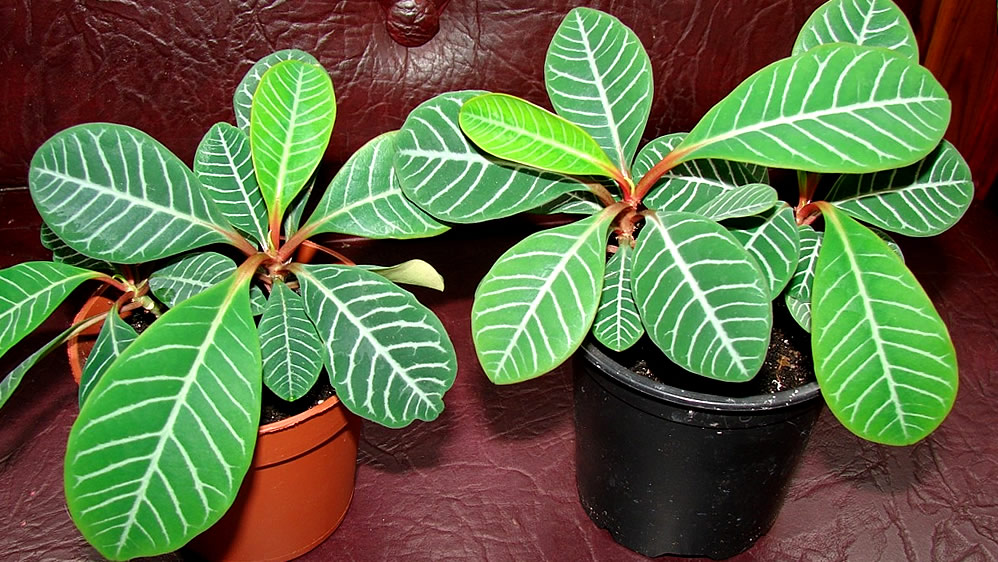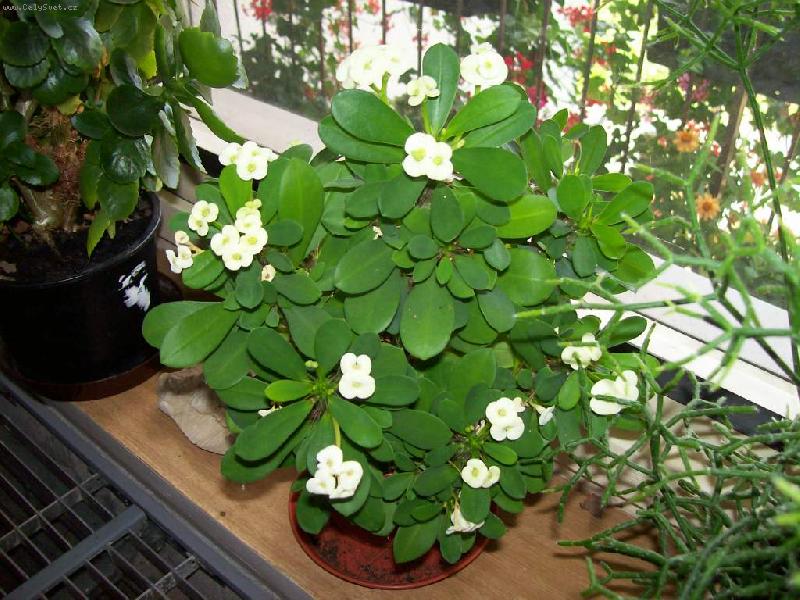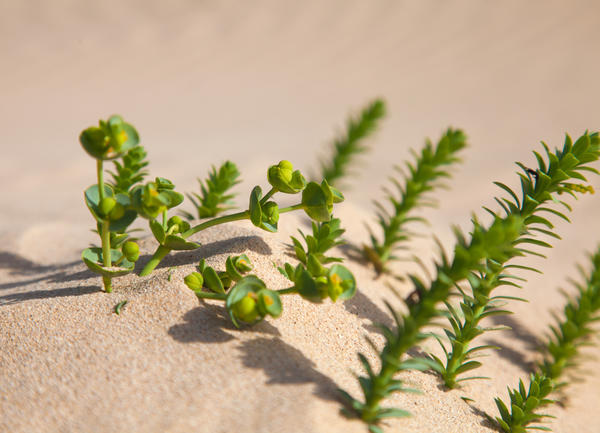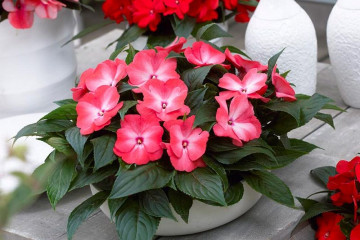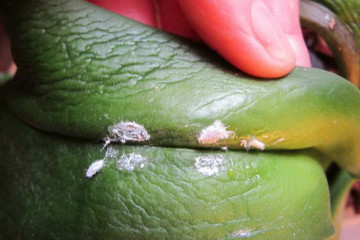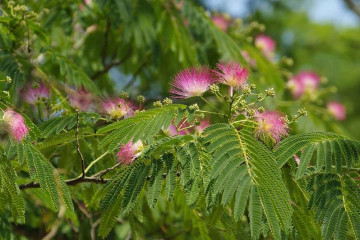Indoor spurge - white-veined, cypress and other types
Content:
Today, flower growers have more than 2000 varieties of milkweed. Each type of ornamental plant has significant differences in appearance: some representatives of milkweed are similar to cacti, others are similar to shrubs and tropical trees. Homeland of indoor milkweed (the second name is euphorbia) Mexico. When grown at home, it is important to provide the euphorbia flower with sufficient sunlight.
Features of room milkweed
Euphorbia (Euphorbia) belongs to the category of succulent plants belonging to the Euphorbia family. The appearance of the different varieties is very different. Among succulent plants you can find:
- herbaceous plants;
- shrubs;
- undersized trees.
The unifying factor of various varieties of milkweed is the presence of milky sap in the tissues of an ornamental culture. The stems can have various forms of thorns. Most euphorbia have powerful stems and a spherical crown. The height indicator can reach 2-200 cm.
The foliage of most varieties contains stipules. The root system of euphorbia plants can be:
- branching;
- creeping;
- vertical.
Common types
Below are the most popular types of milkweed that are grown at home.
- cypress spurge (Euphorbia Cyparissias) belongs to the category of strongly branching shrubs. Under natural conditions, the height of the plant can reach 4-6 m. If the plant is grown indoors, then its height will not exceed 30 cm. The erect branches of the cypress variety are dotted with narrow foliage. Cyantia is located on the tops of the branches. Beautiful bracts are colored yellow-green and red. The cypress variety can be grown in an apartment, and in the warm season it can be transplanted into open ground. In winter, the euphorbia palm must be transplanted back into containers and brought into the house. The cypress species is endowed with useful properties;
- Euphorbia Leuconeura is a popular variety that resembles the appearance of a cactus. The height of the juicy ribbed stem reaches 45-55 cm. The upper parts of the plant are characterized by slight branching. Closer to the lower part, the stem becomes thinner. On the ribs of the stalk of white-veined milkweed, scales are located, giving the culture a fringed appearance. Elongated foliage with oval veins grows in the upper part of the milkweed. When grown indoors, you can achieve abundant flowering. After flowering, a seed capsule is formed, which shoots out as it ripens. After a few weeks, the seed that has fallen into the ground begins to germinate. Euphorbia is a flower that develops rapidly. It is very important not to overdo it with watering. Against the background of swampy soil, the green mass begins to turn yellow. The foliage of the milkweed cactus gradually falls off;
- Triangular Euphorbia (Euphorbia Trigona) is a representative of the stem succulent, which belongs to the Euphorbia family.The perennial has fairly fleshy stems. Small spines are located on pronounced trihedral ribs. Elongated foliage grows on the upper parts of the shoots. A tall plant has a fairly small root system. It is very important to tie the triangular euphorbia to the support as it grows. The variety is unpretentious. Even the dry period euphorbia tolerates well. When grown indoors, flowering does not occur. The indicator of the height of the triangular milkweed reaches 300 cm. The variety is distinguished by the presence of poisonous juice, which provokes the occurrence of skin irritation. Do not allow triangular milkweed juice to get into the eye area. The variety looks ideal when grown in combination with comb and obese species. Recommended to be grown from seed or propagated by cuttings;
- Euphorbia fringed is distinguished by bright bracts with a wide white border. The rounded gray-green foliage of the mountain flower grows slowly. The height of the branched shrub reaches 80-85 cm by August. The border of the bracts in the middle of summer is painted in a snow-white color. One gets the impression that some of the flowers are covered with snow. During this period, euphorbia looks like starched lace. Small white flowers are hardly noticeable. Designers prefer to plant a resinous street variety;
- Euphorbia Tirukalli is a representative of succulent trees, the height of which can reach 9-10 m. Green branches, the thickness of which is within 6-7 mm, have a cylindrical shape. Linear foliage falls off, after which traces in the form of dots remain on the shoots. When grown indoors, the milkweed Tirucalli barely reaches 200-300 cm in height. The variety is easily propagated by cuttings. Plant pots should be placed in areas that receive sufficient sunlight. Tirucalli is able to withstand even long periods of drought. The variety fits perfectly into any landscape design. In the summer, it is better to keep flower pots on the balcony;
- Mila spurge (Euphorbia Milii) belongs to the category of thorny shrubs. The upper parts of the stems are dotted with elongated foliage. The cyanthium bracts are colored in various shades: white, pink and yellow. The height of a plant grown in indoor conditions barely reaches 20-25 cm. In the summer, it is important to water the Mila euphorbia in a timely manner and apply additional fertilizing. The variety reproduces well by cuttings and seed methods. Home care for Milkweed is quite simple. The plant looks amazing during the period when it begins to bloom. Taking care of a perennial variety is not difficult.
Euphorbia is found most often in tropical, temperate and subtropical climates. The homeland of euphorbia is hot Africa and Mexico. A small percentage of plant varieties can be found in cooler climates.
Features of care for milkweed indoor home
Indoor spurge belongs to unpretentious crops. However, when growing at home, it is still necessary to take into account some of the features of caring for a representative of the Euphorbia family.
Transplanting a plant after purchase
Plant acquisition and transplanting is best done in mid-spring. For planting work, it is necessary to prepare a suitable pot, soil mixture and drainage.
Soil preparation
The soil mixture for milkweed transplanting must be loose and permeable to water.If you wish, you can use the soil intended for planting cacti. You can prepare the soil mixture with your own hands. For this purpose, leafy soil, a small percentage of humus and sand are mixed in the bucket. It is important to put a drainage layer on the bottom of the container, using pebbles or expanded clay.
Top dressing
During the growing season, Euphorbia grass needs additional feeding. It is recommended to use preparations containing potassium as fertilizer. Top dressing is applied in the spring and summer months. It is important that the soil is moist at the same time. It is not recommended to make fertilizers from October to March.
Watering the plant
The soil should be moistened according to the scheme below:
- in summer it is enough to water the euphorbia (Euphorbia) every 4-5 days;
- in the cold season, the soil is moistened once every 20 days;
- when the temperature drops below 11 ° C, the soil does not need to be moistened.
During watering, water is added to the pot in small portions in stages. On especially hot summer days, in addition to watering, it is advisable to carry out systematic spraying of plants.
Temperature regime
Experienced florists advise keeping the room temperature within 18-25 ° C. In the hot season, it is necessary to take the flower containers outside. As soon as the outside temperature drops to 16 ° C, the flower pots should be returned to the room.
Lighting
Euphorbia belongs to sun-loving crops that need good lighting. Different varieties require different lighting conditions. If some types of plants need diffused light, then it is important for others to ensure direct sunlight. Some varieties of milkweed can grow in a shaded area. However, the green mass at the same time loses its rich shade and contrast, for example, the variegated variety loses its unusual shade.
Pruning
In mid-July, when the flowering process ends, experts recommend doing anti-aging pruning, during which:
- the stems that have dried are removed;
- stretching shoots are shortened;
- in young plants, all shoots are removed except for young ones, which will delight them with lush flowering in the next season.
In addition to crown correction, formative pruning involves cutting off all shoots towards the end of February, which allows the bushes to become denser. It should be borne in mind that after pruning, flowering can not be expected throughout the year. But the next season, the spurge will delight you with abundant flowering. The crown should be trimmed as carefully as possible.
Reproduction types of indoor flower spurge
To propagate indoor spurge, you can use several methods:
- seed;
- by cuttings;
- dividing the bushes.
Some varieties can only be grown by dividing the bush. For this purpose, the dug out plant bush is divided into a pair of bushes and transplanted into separate containers. It is important to be especially careful when dividing the root system. The method can be applied only at the moment when the plant is at rest. It should be borne in mind that there should be no decaying areas on the planting material. Any suspicion of rot is removed to healthy tissue.
Growing milkweed from seeds
Seed material can be harvested by yourself or purchased from a specialized store.For sowing, you will need to prepare a sand-peat mixture. The soil is calcined in the oven for disinfection purposes. Seeds must be soaked in water for 24 hours. After a specified period of time, bury the seed in the ground. Cover crops with polyethylene material and transfer to a warm room.
Cuttings
Cutting is best done in October. To propagate a plant by a shoot, you will need:
- cut off the processes, the length of which reaches 10 cm from under the leaf nodes;
- remove the lower foliage;
- wash off the released juice under running water;
- wipe the cut and process it with crushed charcoal;
- dry the cuttings and plant in moistened sand.
Until the cuttings take root, they must be kept under a film cover. The soil must be systematically moistened. It is very important to move the cuttings containers to a shaded area.
Diseases and pests
Watering too often can lead to root rot. So that the spurge does not die, it is necessary to remove the rotten roots and transplant it into another pot filled with fertile soil.
Improper plant care can lead to fungal infections. To cope with the disease, you will need to conduct a course of spraying with fungicides. Among the most effective drugs in this category are:
- topaz;
- preicur;
- foundationol.
Parasites can also harm milkweed. Most often the plant is attacked by:
- mealy worms that leave a white coating on foliage and twigs. What to do in this situation? The bugs must be collected, and the plant must be sprayed with infusion of garlic;
- scale insects and thrips, leaving pale yellow stripes on the leaves of the plant. To destroy dangerous parasites, it is recommended to use an actara or phytoverm;
- spider mites, as evidenced by white bloom on the underside of the leaves. The affected areas must be treated with alcoholic infusion.
Possible problems in growing milkweed
Often, when growing milkweed, one can note the occurrence of certain problems. The most common ones include:
- fall of green mass. Most often, an unpleasant situation arises against the background of a lack of sunlight. You should rearrange the containers with flowers as soon as possible in a bright area. You can give preference to places near the window;
- yellowness and drying of the foliage indicate an invasion of parasites or a lack of moisture. It is important to process the plant in a timely manner or moisten the soil;
- wilting can be triggered not only by the influence of pests, but also by an ordinary draft. The flower pots should be rearranged to a more suitable area. If necessary, treatment for parasites is carried out.
Euphorbia belongs to the category of fairly unpretentious plants that can be grown not only indoors, but also in the garden in the summer. The abundance of flower varieties will help you choose the perfect plant for any interior design.
